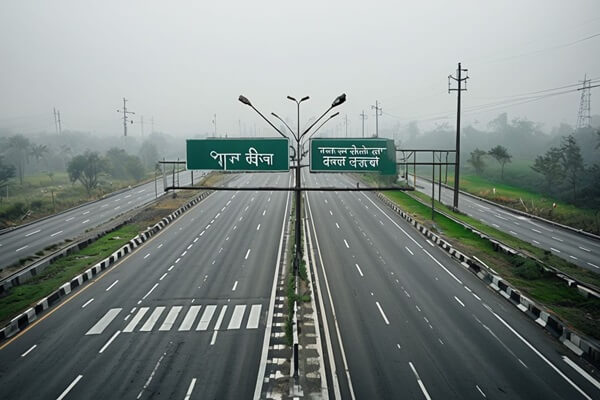Yamuna Expressway or Taj Expressway Route Map
The Yamuna Expressway, officially known as the Taj Expressway, is a landmark in India’s infrastructure development. Spanning approximately 165.5 kilometers, this access-controlled expressway connects Delhi with Agra, transforming the travel landscape between these two iconic cities. Opened to the public on August 9, 2012, by former Uttar Pradesh Chief Minister Akhilesh Yadav, the expressway has become a vital artery for commerce and tourism, providing a seamless link between the national capital and Agra, home to the magnificent Taj Mahal.
Overview of the Yamuna Expressway
Constructed to alleviate the heavy traffic congestion that plagued older routes, particularly NH-2, the Yamuna Expressway aims to promote economic growth in the region. Designed as a six-lane highway, with the potential to expand to eight lanes, it facilitates smoother traffic flow, allowing vehicles to maintain higher speeds. The project was developed by the Yamuna Expressway Industrial Development Authority (YEIDA) in partnership with Jaypee Infratech Limited, with a total project cost estimated at around Rs 13,300 crore.
Key Features:
- Length: 165.5 km
- Type: Access-controlled expressway
- Design Speed: 120 km/h
- Speed Limit: 80 km/h for cars, 60 km/h for heavy vehicles
- Pavement: Rigid (Concrete)
- Interchanges: 7 major interchanges along the route
- Toll Rates:
- Two-wheelers: Rs. 240
- Cars: Rs. 510
- Buses: Rs. 1680
Enhancements in Travel Experience
One of the most significant benefits of the Yamuna Expressway is the drastic reduction in travel time. The journey between Delhi and Agra, which once took over three hours, can now be completed in approximately two and a half hours. This time-saving aspect is crucial for business travelers and tourists alike, making the expressway a preferred choice for both daily commutes and leisure trips.
The expressway is equipped with state-of-the-art features to enhance safety and ensure a smooth travel experience. It boasts a comprehensive Intelligent Transport System (ITS) that includes mobile radars to monitor speed limits and CCTV surveillance for real-time traffic management. Highway patrols are stationed every 25 kilometers to assist motorists, ensuring quick responses to any emergencies or breakdowns. Additionally, the expressway features long flyovers and several major bridges, showcasing remarkable engineering.
Economic Impact and Real Estate Growth
The Yamuna Expressway has catalyzed significant economic development in the regions it connects. By providing a faster and more efficient route between Delhi and Agra, the expressway has attracted a surge in investments, particularly in the real estate sector. Townships, commercial hubs, and industrial zones have sprung up along the expressway, driven by the increasing demand for residential and commercial spaces.
Several real estate projects, including residential complexes, commercial establishments, and industrial parks, have emerged in Greater Noida, Jewar, and other areas along the expressway. The expressway’s proximity to the upcoming Taj International Airport in Jewar further enhances its appeal, as the airport is expected to become a significant center for trade and travel, driving further investment in the surrounding areas.
Moreover, the expressway has bolstered tourism in Agra, making it easier for travelers to visit the Taj Mahal and other historical sites. Tour operators have reported an increase in bookings as more visitors opt for the quick and convenient access the expressway provides. This boost in tourism not only benefits local businesses but also contributes to the overall economy of the region.
Also read: Mumbai Pune Expressway Route Map
Environmental Considerations
While the Yamuna Expressway has undoubtedly brought about numerous benefits, it is essential to address the environmental considerations associated with such large infrastructure projects. The construction and operation of the expressway have raised concerns about pollution, habitat destruction, and the ecological impact on the surrounding areas, particularly the Yamuna River. Measures must be implemented to mitigate these impacts, such as enhancing green cover along the route and employing eco-friendly construction practices.
Efforts should include creating noise barriers, maintaining green belts, and implementing effective waste management strategies. Engaging with local communities and environmental experts can also help ensure that the expressway’s benefits do not come at the cost of ecological health.
Future Prospects
The future of the Yamuna Expressway looks promising, with plans for further expansion and enhancement. Ongoing developments in the surrounding areas, particularly with the upcoming Taj International Airport, are expected to significantly increase the expressway’s traffic volume. Additionally, the expressway serves as a crucial link in India’s broader transportation network, connecting with other major highways and expressways, facilitating seamless travel across the region.
Government initiatives aimed at improving road infrastructure and connectivity are likely to lead to additional investments in the expressway. Furthermore, with the growing emphasis on sustainable transportation and green initiatives, the integration of electric vehicle charging stations and other eco-friendly facilities along the expressway can enhance its utility and appeal.
Community Engagement
Community engagement plays a critical role in the future development of the Yamuna Expressway. Involving local residents in planning and decision-making processes can lead to better outcomes. This includes soliciting feedback on potential expansions, traffic management solutions, and environmental protection measures.
Conclusion
The Yamuna Expressway is more than just a highway; it symbolizes progress, connectivity, and economic growth for the region. Its impact on travel, tourism, and real estate has been profound, transforming the landscape between Delhi and Agra and creating new opportunities for businesses and individuals alike.
As the expressway continues to evolve, it holds the potential to drive further growth and development, making it a critical component of India’s infrastructure framework. By addressing environmental concerns and adapting to future demands, the Yamuna Expressway can pave the way for sustainable development, ensuring it remains a vital corridor for years to come.
This magnificent infrastructure project not only connects two historical cities but also fosters economic prosperity and enhances the overall quality of life for those living in its vicinity. The Yamuna Expressway is indeed a testament to India’s vision for a connected and prosperous future.




Post Comment